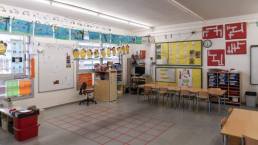Project
The Need to Adapt School Classrooms to Global Warming: Climate Plan for Barcelona’s Public Schools
The Need to Adapt School Classrooms to Global Warming: Climate Plan for Barcelona’s Public Schools
Barcelona, like many other cities around the world, has experienced a significant increase in average temperatures in recent years. A worrying aspect is how this trend of rising temperatures affects schools and, consequently, students’ learning and cognitive ability. The increase in temperature in Barcelona is particularly noticeable in the months of May and June, with an increase of 1.38 °C and 2.79 °C, respectively, from the years 1780-1800 to the years 2010-2022.
The Study
Faced with this reality, Aiguasol has proposed a study with the aim of finding solutions applicable to all schools built in Barcelona, through the development of a methodology to analyze the thermal needs of school classrooms in the city.
In addition, this study also included the potential for electricity production in the schools from renewable sources (photovoltaic), to cover the increase in electricity consumption that would result from the installation of air conditioning to improve ventilation and cooling the classrooms in summer.
The study is part of the “New School Climate Plan” aimed at public schools in Barcelona, and promoted by the Barcelona City Council and the Education Consortium.
The research methodology is divided into two phases:
- Characterization Phase: In this stage, the factors that affect the interior conditions of the classrooms in relation to thermal comfort during the hot months are identified. These factors include the year of construction of the building, its orientation, exterior protections and other relevant aspects.
- Simulation Phase: Using the TRNSYS simulation tool and parametric simulation techniques, the classrooms are modeled and simulated in different configurations. This makes it possible to calculate the cooling needs to ensure the thermal comfort of the students and to evaluate the energy demand and consumption associated with this cooling.
The results of the study define two scenarios. The first is the unfavorable case, which considers the worst possible conditions, including the least optimal orientation and the presence of school activities during the month of July. The second is the favorable case, which foresees the best conditions, such as classrooms on the first floor and no activities during the month of July.
In collaboration with the Education Consortium, several scenarios have been established to provide resilience in the project, ensuring compliance with RITE (Regulation of Thermal Installations in Buildings) in terms of thermal comfort and indoor air quality, considering the school activity during the month of July.
Solutions
The solutions presented address two key needs in school classrooms: to ensure the healthiness and air renewal of the space, and to provide thermal comfort during the warmer months.
In response to the problems in terms of health and air renewal, the so-called REN-A solution has been proposed, a centralized air renewal by means of an Air Treatment Unit (ATU), with flow calculation according to the RITE prescriptive method.
On the other hand, as a response to the problem in terms of thermal comfort, the so-called GEN-B solution has been proposed, i.e. the generation of thermal energy by means of a heat pump with water distribution and emission via fan-coils installed in the classrooms.
This holistic approach addresses both the health and thermal comfort of students and the energy efficiency and sustainability of air conditioning and cooling systems, which contributes to the quality of education in these spaces and the durability of school facilities.
In addition, the solutions have been designed taking into account general strategies to increase the resilience of the buildings and their capacity to adapt to future needs, without neglecting the usual considerations in the construction of educational centers.
Towards a more sustainable education
The rehabilitation and adaptation of buildings to new needs can be complex, but in the case of schools, there are technologically mature solutions that make it possible to ensure quality space and education, regardless of environmental conditions. These solutions include efficient architectural configuration, the use of renewable energy sources and technologies that reduce investment costs. In addition, new cooling demands can be offset by energy savings.
It is essential that authorities and educational institutions take concrete actions to address this challenge and create a more sustainable future. The air conditioning and ventilation of Barcelona’s public schools will directly benefit 55,519 students in the city, corresponding to all the centers in which the City Council is responsible for maintenance and renovation.
The plan will be carried out in 148 schools, 3 special education schools and 3 high schools and will be divided into two three-year phases, with 83 centers between 2024 and 2026 and 87 between 2027 and 2029.
The “New School Climate Plan” is a significant step towards a Barcelona that is more respectful of the planet and people, ensuring an optimal environment for students’ learning and growth, as well as improving the quality of life in the city’s educational spaces.


